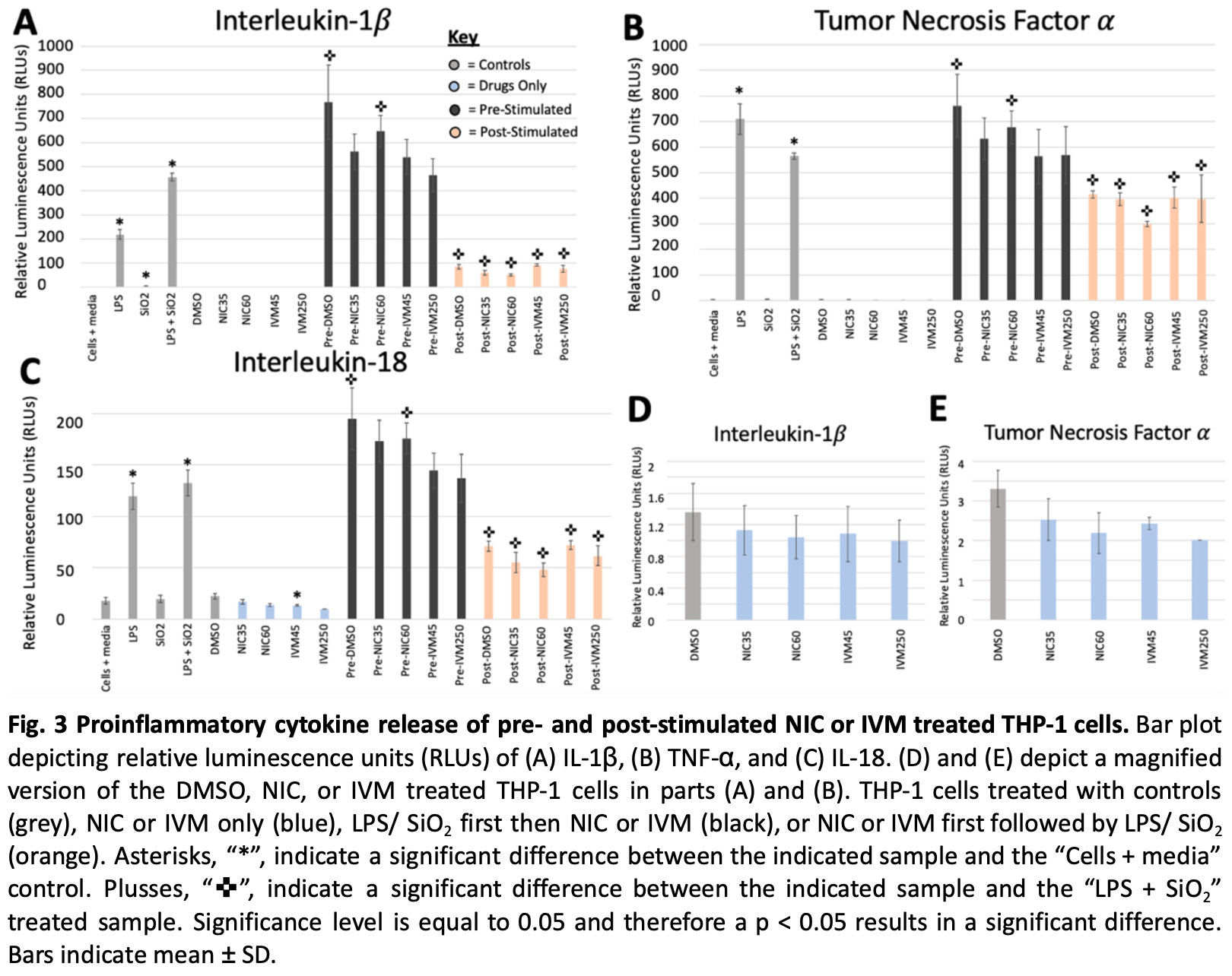Niclosamide and ivermectin modulate caspase-1 activity and proinflammatory cytokine secretion in a monocytic cell line
Micheal C Munson, Danielle Brain, Christopher David, Andrew Owen, Dr Neill J Liptrott
The COVID-19 pandemic has led to an unprecedented demand for new and repurposed therapeutics to ameliorate the morbidity and mortality associated with SARS-CoV-2 infection. However, there is still a paucity of information relating to successful antiviral compounds. The repurposing of immune modulators, such as dexamethasone and tocilizumab, has shown significant improvement in survival rates. Repurposing of small molecules that may have antiviral and immunomodulatory potential may have significant impact on the pandemic. Niclosamide and ivermectin are being investigated for repurposing as potential treatments for COVID-19 patients. Both niclosamide and ivermectin have been proposed and studied based upon possible immunomodulatory and antiviral activity. To improve their posology, there are also ongoing efforts to nano-formulate these drugs, but a much greater understanding of their mechanisms of action is required to rationalise their plausibility as candidates. We have previously shown that niclosamide can affect responses to immune stimulation in ex vivo cells from healthy rats exposed via a long-acting injectable formulation. The current study aimed to further understand the effects of niclosamide and ivermectin on inflammasome activity in human cells due to the involvement of inflammasomes in the hyperinflammation and coagulation observed in severely ill COVID-19 patients. Caspase-1 activity and proinflammatory cytokine secretion in THP1 cells exposed to physiologically-relevant concentrations of niclosamide and ivermectin were measured as markers of inflammasome activity. Exposure to both niclosamide and ivermectin led to lower caspase-1 activity compared to untreated cells as well as resulting in lower secretion of IL-1β, IL-18, and TNF-α if treated prior to LPS induction. These data in their own right should not be interpreted as being a conclusive indicator of the utility of these drugs in COVID-19. However, the data presented suggests a putative mechanism for the proposed immune modulation. Substantive further work is still needed to determine the precise mechanism(s) that underpin these findings and whether the observations are relevant in vivo.
References
Arshad, Prioritization of Anti-SARS-Cov-2 Drug Repurposing Opportunities Based on Plasma and Target Site Concentrations Derived from their Established Human Pharmacokinetics, Clinical Pharmacology & Therapeutics
Baker, A call for the appropriate application of clinical pharmacological principles in the search for safe and efficacious COVID-19 (SARS-COV-2) treatments, British Journal of Clinical Pharmacology
Cavalcanti, Hydroxychloroquine with or without Azithromycin in Mild-to-Moderate Covid-19, New England Journal of Medicine,
doi:10.1056/NEJMoa2019014Chen, Clinical and immunological features of severe and moderate coronavirus disease 2019, J Clin Invest
Hobson, Scalable nanoprecipitation of niclosamide and in vivo demonstration of long-acting delivery after intramuscular injection, Nanoscale
Liang, Inhibitory effects of niclosamide on inflammation and migration of fibroblast-like synoviocytes from patients with rheumatoid arthritis, Inflamm Res
Merad, Martin, Pathological inflammation in patients with COVID-19: a key role for monocytes and macrophages, Nature Reviews Immunology
Muñoz, Safety and pharmacokinetic profile of fixed-dose ivermectin with an innovative 18mg tablet in healthy adult volunteers, Nature Reviews Immunology
Pinho, EMA recommends COVID-19 Vaccine AstraZeneca for authorisation in the EU
Pneumonia, None, New England Journal of Medicine
Prabhakara, Niclosamide inhibits SARS-CoV2 entry by blocking internalization through pH-dependent CLIC/GEEC endocytic pathway, bioRxiv,
doi:10.1101/2020.12.16.422529Qin, Dysregulation of Immune Response in Patients With Coronavirus 2019 (COVID-19) in Wuhan, China, Clin Infect Dis
Rannard, Chasing COVID-19 chemotherapeutics without putting the cart before the horse, British Journal of Clinical Pharmacology n/a
Salama, Tocilizumab in Patients Hospitalized with Covid-19
Schweizer, A phase I study of niclosamide in combination with enzalutamide in men with castration-resistant prostate cancer, PLoS One
Skipper, Hydroxychloroquine in Nonhospitalized Adults With Early COVID-19 : A Randomized Trial, Ann Intern Med
Thi Tran, Kitami, Niclosamide activates the NLRP3 inflammasome by intracellular acidification and mitochondrial inhibition, Communications Biology
Wu, Inhibition of severe acute respiratory syndrome coronavirus replication by niclosamide, Antimicrob Agents Chemother
Yang, Recent advances in the mechanisms of NLRP3 inflammasome activation and its inhibitors, Cell Death & Disease
Yao, Vitro Antiviral Activity and Projection of Optimized Dosing Design of Hydroxychloroquine for the Treatment of Severe Acute Respiratory Syndrome Coronavirus 2 (SARS-CoV-2), Clin Infect Dis
Zhang, Ivermectin inhibits LPS-induced production of inflammatory cytokines and improves LPS-induced survival in mice, Inflamm. res
